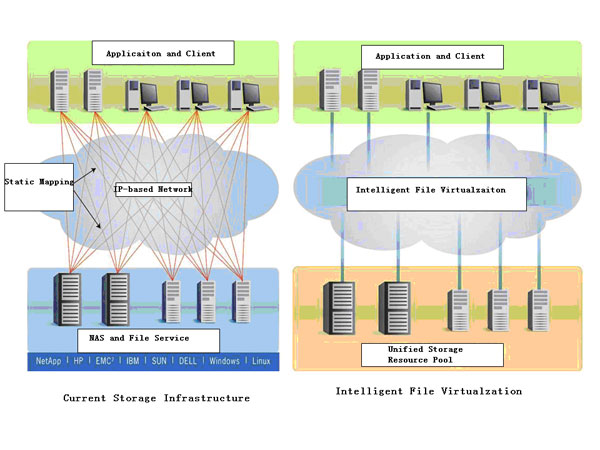In front of the increasing information, it has been a challenge for all enterprises as how to better administration and store the information. The rate of information generation has reached an unprecedented degree, and the information has to be kept longer in view of the demand of administration and business. Besides, since the operation budget is always behind the rapid increase of storage volume demand, IT enterprise must utilize few resources to complete more tasks.
File storage architecture of the enterprise generally faces following situations:
1) Complicated administration. Ordinary storage architecture of the enterprise consists of a series of storage platform, file system and operating system, which may come from different suppliers and a single device has to be administrated as an “isolated island” of storage;
2) Insufficient flexibility of resource configuration. User and application program are statically mapped to the physical file storage resource containing the data to be visited. Under some circumstances, it may produce hundreds or thousands of independent maps (or installation points). Once the file storage environment is changed, e.g. these static maps will be damaged when providing the new storage or moving the fire, and manual configuration and system shutdown are necessary when updating the environment;
3) Low efficiency of storage. Although certain file servers or network access storage (NAS) devices are highly utilizes, generally speaking, the file storage device is not fully utilized that its average utilization rate in most enterprises only reaches 40-50%;
4) Large-scale increase of unstructured data. Volume demand is rapidly growing and file data occupies over 70% of the growth. It further intensifies this problem: along with the growth of storage demand, storage device has to be continuously supplemented, but it makes the environment more complicated, less flexible and less efficient.
Constant demand for large storage volume and more cost in storage administration increase the storage cost in a screwed way. Therefore, there must a better method to administrate such rapidly growing file storage architecture without correspondingly increasing the administration cost.
Virtual file storage administrator may effectively assist you in optimizing the storage architecture to elevate the storage utilization rate, reduce the storage cost and simplify the storage administration method by the most reasonable and maximum realization of ROI.

Intelligent virtual administration layer of file brings some advantages to your environment: 1) simplified visit; 2) increased flexibility; 3) optimized utilization rate; 4) storage layer administration.
